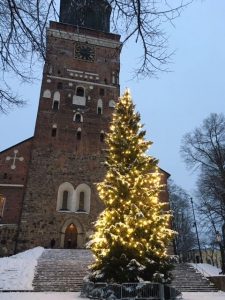

Greetings from Finland! The snow finally arrived and made the dark time of the year a little bit lighter. The winter solstice is just days away and then we will be again heading towards longer days.
All right, now let us move forward in my blogging week. I wrote about Finland’s situation at the moment in the field of education. Many of these issues have pushed me to work with schools and libraries and to try to make a difference.

Turku Cathedral
I am interested in information literacy and how it is present in the Finland’s national core curriculum, and how teachers and school librarians understand these terms. The curriculum is not giving any definitions for information managing or information literacy. Five teachers and five school librarians in the same schools were asked how they understand information managing, information literacy and multiliteracy (to clear things out, they more or less have the same substance, but still with clear differences). The results were very interesting. Information literacy is a term of information science but the other two are more from the pedagogical side. I assembled a model of the answers and saw that both professions concentrate in their understanding to information searching and critical thinking. Librarians even more than the teachers.
Then, what about the core curriculum? In an open analysis I was able to come up with a model with 13 stages. I then divided the model into three parts, pre-information searching, information searching and post-information searching. With this I want to emphasise, that information seeking needs preparation and the found information needs to be worked with.
There has to be some preconditions how teachers in the learning situation should prepare the class. One of the most interesting findings was the phase inquiring mind. The 2014 core curriculum is emphasising student to be curious and study issues from a new perspective and with an open mind. A teacher is expected to encourage students in this.

Santa Lucia, the bringer of light, celebrated in Turku.
The interesting finding is that most of the times when information literacy issues were mentioned in the curriculum findings belonged to the post-information searching part. This was different from both teachers and school librarians. The core curriculum is however emphasising how the students should be taught to work with the found information. This finding gave me a lot of joy, since my experience and also the research literature shows that this is the difficult part with student. Reviewing, summarising, comparing, compiling, and not just trying to get ready ASAP. The very interesting finding in all this was, that the 2004 had exactly similar emphasis with a little bit different terminology.
The results in full can be read in the thesis next year, but personally I am very exited about the results. The problems in students’ information seeking has been proved in the classroom and in research for the last 20 years. It has also been named, that teachers don’t have tools to meet these difficulties in students’ information behaviour.
Now Finland has a good curriculum, only thing is to make this work! And in my mind, GID has really a role to play!
With best greetings from Finland,
Anu
Hi Anu,
Very interesting post! I am always interested to hear about the Finnish education system, of which I hear a good bit, but I haven’t heard too much about their school library system. Thanks for sharing.
Now let me go back and read your other posts that I must have missed:-)